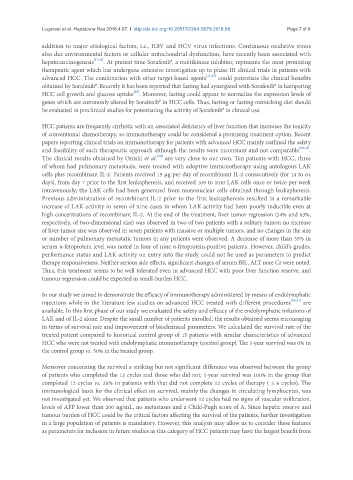Page 753 - Read Online
P. 753
Lugaresi et al. Hepatoma Res 2018;4:67 I http://dx.doi.org/10.20517/2394-5079.2018.88 Page 7 of 9
addition to major etiological factors, i.e., HBV and HCV virus infections. Continuous oxidative stress
also due environmental factors or cellular mitochondrial dysfunction, have recently been associated with
hepatocarcinogenesis [17,18] . At present time Sorafenib®, a multikinase inhibitor, represents the most promising
therapeutic agent which has undergone extensive investigation up to phase III clinical trials in patients with
advanced HCC. The combination with other target-based agents [14,15] could potentiate the clinical benefits
obtained by Sorafenib®. Recently it has been reported that fasting had synergized with Sorafenib® in hampering
[19]
HCC cell growth and glucose uptake . Moreover, fasting could appear to normalize the expression levels of
genes which are commonly altered by Sorafenib® in HCC cells. Thus, fasting or fasting-mimicking diet should
be evaluated in preclinical studies for potentiating the activity of Sorafenib® in clinical use.
HCC patients are frequently cirrhotic with an associated deficiency of liver function that increases the toxicity
of conventional chemotherapy, so immunotherapy could be considered a promising treatment option. Recent
papers reporting clinical trials on immunotherapy for patients with advanced HCC mainly outlined the safety
and feasibility of such therapeutic approach although the results were inconstant and not comparable [20,21] .
[20]
The clinical results obtained by Onishi et al. are very close to our own. Ten patients with HCC, three
of whom had pulmonary metastasis, were treated with adoptive immunotherapy using autologous LAK
cells plus recombinant IL-2. Patients received 15 μg per day of recombinant IL-2 consecutively (for 14 to 64
days), from day 7 prior to the first leukapheresis, and received 109 to 1010 LAK cells once or twice per week
intravenously; the LAK cells had been generated from mononuclear cells obtained through leukapheresis.
Previous administration of recombinant IL-2 prior to the first leukapheresis resulted in a remarkable
increase of LAK activity in seven of nine cases in whom LAK activity had been poorly inducible even at
high concentrations of recombinant IL-2. At the end of the treatment, liver tumor regression (34% and 63%,
respectively, of two‐dimensional size) was observed in two of two patients with a solitary tumor; no increase
of liver tumor size was observed in seven patients with massive or multiple tumors, and no changes in the size
or number of pulmonary metastatic tumors in any patients were observed. A decrease of more than 35% in
serum α‐fetoprotein level was noted in four of nine α‐fetoprotein‐positive patients. However, child’s grades,
performance status and LAK activity on entry into the study could not be used as parameters to predict
therapy responsiveness. Neither serious side effects, significant changes of serum BIL, ALT nore Cr were noted.
Thus, this treatment seems to be well tolerated even in advanced HCC with poor liver function reserve, and
tumour regression could be expected in small‐burden HCC.
In our study we aimed to demonstrate the efficacy of immunotherapy administered by means of endolymphatic
injections while in the literature few studies on advanced HCC treated with different procedures [20,21] are
available. In this first phase of our study we evaluated the safety and efficacy of the endolymphatic infusions of
LAK and of IL-2 alone. Despite the small number of patients enrolled, the results obtained seems encouraging
in terms of survival rate and improvement of biochemical parameters. We calculated the survival rate of the
treated patient compared to historical control group of 15 patients with similar characteristics of advanced
HCC who were not treated with endolymphatic immunotherapy (control group). The 1-year survival was 0% in
the control group vs. 50% in the treated group.
Moreover concerning the survival a striking but not significant difference was observed between the group
of patients who completed the 12 cycles and those who did not; 1-year survival was 100% in the group that
completed 12 cycles vs. 20% in patients with that did not complete 12 cycles of therapy ( ≤ 6 cycles). The
immunological basis for the clinical effect on survival, mainly the changes in circulating lymphocytes, was
not investigated yet. We observed that patients who underwent 12 cycles had no signs of vascular infiltration,
levels of AFP lower than 200 ng/mL, no metastases and a Child-Pugh score of A. Since hepatic reserve and
tumour burden of HCC could be the critical factors affecting the survival of the patients, further investigation
in a large population of patients is mandatory. However, this analysis may allow us to consider these features
as parameters for inclusion in future studies as this category of HCC patients may have the largest benefit from

